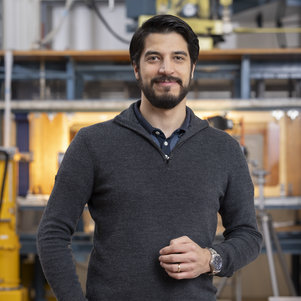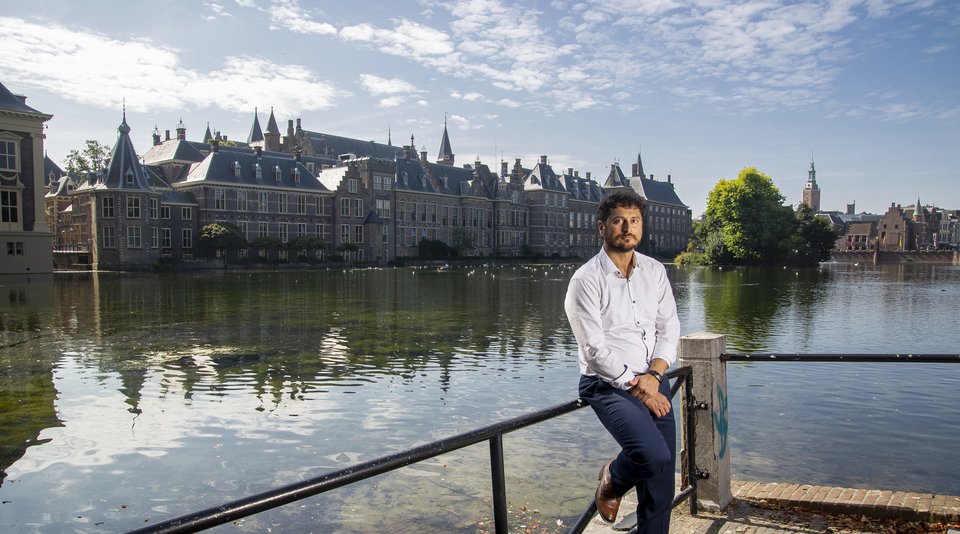Reducing aerodynamic drag can unlock significant fuel savings in the aviation industry. To reduce the drag of an aircraft, it is important to maximise the extent of laminar air flow around it and minimise turbulent air flow. Thanks to a revolutionary, and unexpected discovery, the research group of Professor of Flow Control Marios Kotsonis managed to extend laminar flow on swept wings. Will this unexpected research result lead to a breakthrough for climate neutral aviation?
December 14th 2023
The greater the aerodynamic drag, or air resistance, the more energy your need to move forward through air. It’s as true for bike rides as it is for any type of transport, including aviation. And because this energy comes from fuel, minimising drag will play an important part on the road to cleaner aviation, Marios Kotsonis explains. “You can affect drag by manipulating air flow around an aircraft. And that’s exactly what we do in our Flow Control team that consists of MSc students, PhD candidates and postdocs. We study how air flows behave and how can they be controlled.”
Calm and chaotic
There are roughly two categories of air flow, Kotsonis explains: laminar flow and turbulent flow. “When air hits the nose or wings of an aircraft, it is always laminar and spreads across the surface calmly and smoothly. As a result, there is very low friction, which means drag is low. At a certain point, however, the air flow transitions from laminar to turbulent, fluctuating rapidly and chaotically and significantly increasing drag. At the end of the day, you want to delay the transition from laminar to turbulent air flow as long and as far as possible.”
The difference between turbulent flow and turbulence
Please don’t confuse a turbulent flow with turbulence the way we know it as passengers in an aircraft. Turbulence involves large-scale vibration of the aircraft. The turbulence in a flow is a different phenomenon. A turbulent flow is an irregular swirling flow of a gas (such as air) or liquid (such as water). The flow takes place at high flow velocities.
Air flow on swept wings
Kotsonis' research group mainly studies laminar flow on swept-wings of aircraft, with postdoc Alberto Rius Vidales explaining that the transition from laminar to turbulent flow is a typical feature of this type of wing. “You’ll find swept wings on virtually all passenger aircraft across the world. They’re positioned at an angle with respect to the body of the aircraft to reduce shockwaves at high speeds. However, when it comes to transition, the angled wings behave differently than their straighter counterparts.”
Imperfections affect transition
One of the major challenges in preserving laminar flow for as long as possible is the fact that swept wings consist of multiple panels, Rius Vidales explains. “The panels are screwed together and the joints between the panels produce small imperfections on the wing, known as steps. All these imperfections affect the transition from laminar to turbulent flow: the larger these steps, the sooner the transition will take place." Roughness is not always bad. In fact, another well-known discovery of the TU Delft from the 90s are zig-zag strips, used on gliders and speed skaters to accelerate transition and enhance turbulent flow. In these cases one wants more turbulent flow to avoid unwanted flow separation which increases pressure drag and reduces lift.
However, for large airliner wings in cruise altitude one wants as much laminar flow as possible, and for that you have to minimise roughness on the wing. During the group’s wind tunnel testing, however, they discovered that this is not always the case.
A groundbreaking discovery
During one such test in 2019, Rius Vidales, then a PhD candidate, chanced upon a discovery that was equal parts surprising and groundbreaking. “We were actually investigating the adverse effects of forward-facing steps on swept wings, expecting them to expedite the transition from laminar to turbulent flow. To our surprise, however, we discovered that for a very particular design of the step geometry, rather than advancing the transition front, they actually postponed it. It was a quite counterintuitive finding and we couldn’t believe what we were seeing at first.”
Turning the scientific process upside down
Several repeat tests, mathematical calculations and simulations all pointed to the same conclusion. Kotsonis: “That’s when we realised that we had something special. Basically, we had turned the scientific process upside down. Usually, you observe something, draw up a hypothesis and test whether your hypothesis is correct. This time round, we observed an entirely counterintuitive and groundbreaking phenomenon that forced us to redesign our entire plan, which was quite a challenge.”
Development of the laminar hump
The findings prompted follow-up research on the forward-facing step that delayed the transition to turbulent flow. Kotsonis: “We used a series of calculations and experiments to find ways to amplify the effect. In the end, we found a way to smoothen and lengthen the step, which eventually we called the Delft Laminar Hump, or DeLah. Because of its pioneering nature, and its simplicity, we also chose to patent it.”
A true team effort
According to Rius Vidales, developing the DeLaH was a true team effort of all researchers in the group of Kotsonis. Overall, experiments, calculations, and computer simulations of the research group all pointed to the same innovative results. However, the fundamental working principle of the Hump is still largely unknown. Kotsonis: “We know that it works under some conditions, but not exactly why. Understanding this is the next key stage in our research.”
But does it work in practice?
A second key question that the researchers are eager to answer is ‘Will the DeLaH actually work in practice?’ Rius Vidales: “So far, our tests have been small-scale. These small-scale tests are essential to prove that the concept works. But will our hypotheses and theories hold up when the hump is installed on a real wing? In wind tunnel tests at conditions closer to real flight we will investigate how we should design DeLaH – and if it works – in practice.”
Market research with industry partners
Recently, the research group was awarded a European Research Council Proof-of-Concept grant. Kotsonis was delighted with the news: “Their support has brought us one step closer to the market. Part of the funding will be put towards market research to find out if our technology is compatible with the plans and operations of aircraft manufacturers and companies. The talks we’re having with industry partners such as Airbus and KLM will help us decide what to focus on as we move forward. Naturally, they’re also eager to find out how they stand to benefit, especially when it comes to fuel savings.” The group have also received a start-up voucher from the TU Delft Aerospace Innovation Hub to help them on their way to a start-up company.
Potentially huge energy gains
A few rough calculations are all it takes for Kotsonis to highlight the enormous potential of the DeLaH: “Making a swept wing 50% laminar would result in fuel savings of about 15 percent. To put that in perspective, fuel consumption only improves by about 2 to 3 percent with each new generation of aircraft. And that’s the aggregate improvement yielded by all sorts of improvements made to the engine and aerodynamics. With the DeLaH, a single, relatively simple adjustment could yield considerably greater gains.”
With a single, relatively simple adjustment we could yield considerably greater gains.
Marios Kotsonis
To adjust or redesign from the ground up
It is difficult for Rius Vidales to say whether implementing the Laminar Hump requires a full redesign from the ground up or whether existing wing designs can be tweaked. “That’s one of the things we will have to investigate. In the models we used for our experiments, we integrated the Hump into existing wings. The main advantage of the Hump is that it does not have to be controlled – which would require an energy source – but consists of a one-off adjustment to the wing.
Controlling the (virtually) uncontrollable
Both Kotsonis and Rius Vidales are proud to make a contribution to greening aviation with their research on laminar flow. Kotsonis: “What I like most about the field of Flow Control is that, at its core, it’s about controlling the uncontrollable. We feel air flow around us every day, but there’s little we can do about it. Working with aircraft does give you a modicum of control, and that’s exactly what makes this research so exciting.”
Teamwork
Developing the DeLaH was real teamwork. Computer simulations carried out by Jordi Casacuberta Puig in the Dutch National Supercomputer confirmed the results from the wind tunnel experiments of Alberto Rius Vidales. Casacuberta then formulated equations that explain the aerodynamic benefits of the surface steps and how to optimise them. From the knowledge gained on the steps, computer simulations by Sven Westerbeek were the key to ultimately design the geometry of the DeLaH, as confirmed by experiments of Rius Vidales and Luis Morais. Finally, wind tunnel experiments of Giulia Zoppini and Theo Michelis also found that arrays of surface steps can extend the laminar air flow even more than one single step. This opens the door for new designs of DeLaH, possible in an array configuration. Overall, experiments, calculations, and computer simulations of the group all pointed towards the same innovative results. However, the fundamental working principle of the Hump is still largely unknown. Kotsonis: “We know that it works under some conditions, but not exactly why. Understanding this is the next stage in our research together.”





















